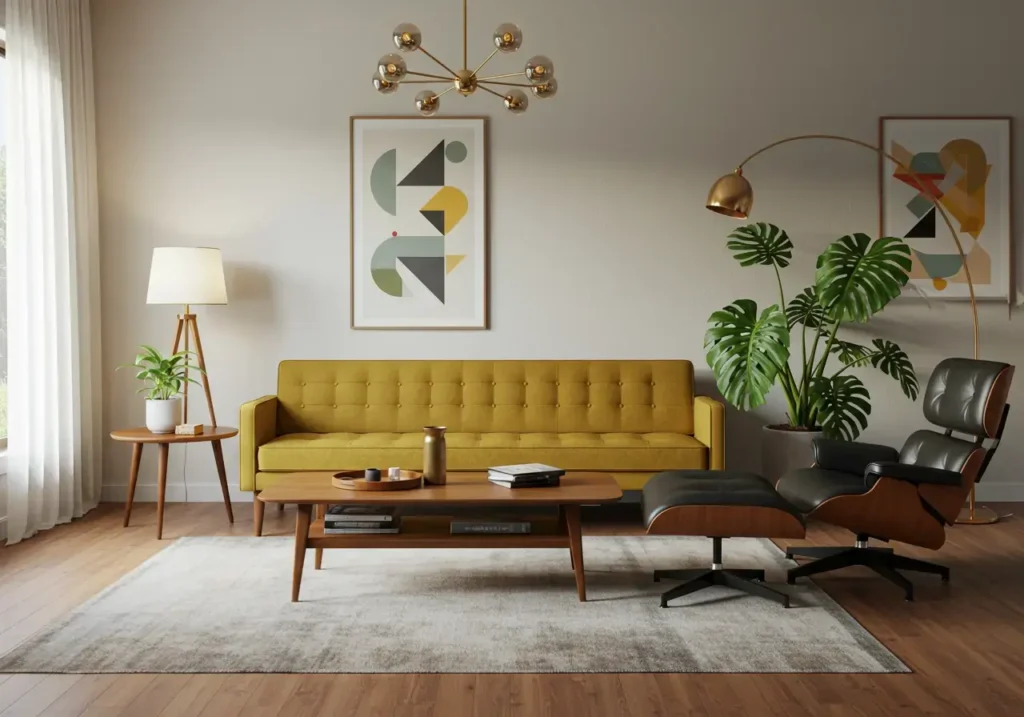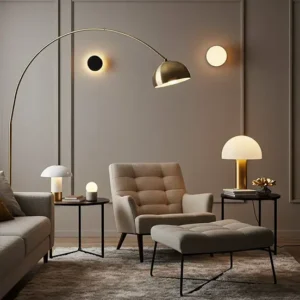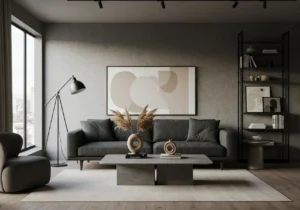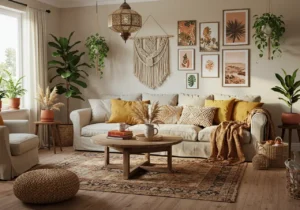Oh, the allure of the mid-century modern living room! There’s just something so timeless, so effortlessly cool, about that iconic style. It’s a design era that truly speaks to me, and over the years, I’ve found myself repeatedly drawn to its clean lines, organic shapes, and a certain playful sophistication. If you’re anything like me, you probably dream of transforming your living space into a haven of retro charm, a place where Mad Men meets cozy comfort. I’ve spent countless hours, from hunting for vintage treasures to experimenting with color palettes, all to capture that perfect mid-century vibe. And trust me, it’s not just about replicating a look; it’s about crafting a feeling, a space that truly feels lived-in and loved. So, if you’re ready to dive into the world of slim silhouettes and natural materials, join me as I share my go-to 13 Mid-Century Living Room Ideas for Retro Charm to bring that classic coolness right into your home.
Mid-Century Living Room Furniture Essentials
When I first started dabbling in mid-century design, I realized quickly that furniture is where it all begins. It’s the backbone of the entire aesthetic. Think about those iconic pieces: slim profiles, tapered legs, and a perfect blend of form and function. It’s all about furniture that looks good but also serves a purpose without being bulky. I remember finding my first vintage credenza; it just instantly transformed the feel of the room. It’s truly all about creating a sense of openness and light.
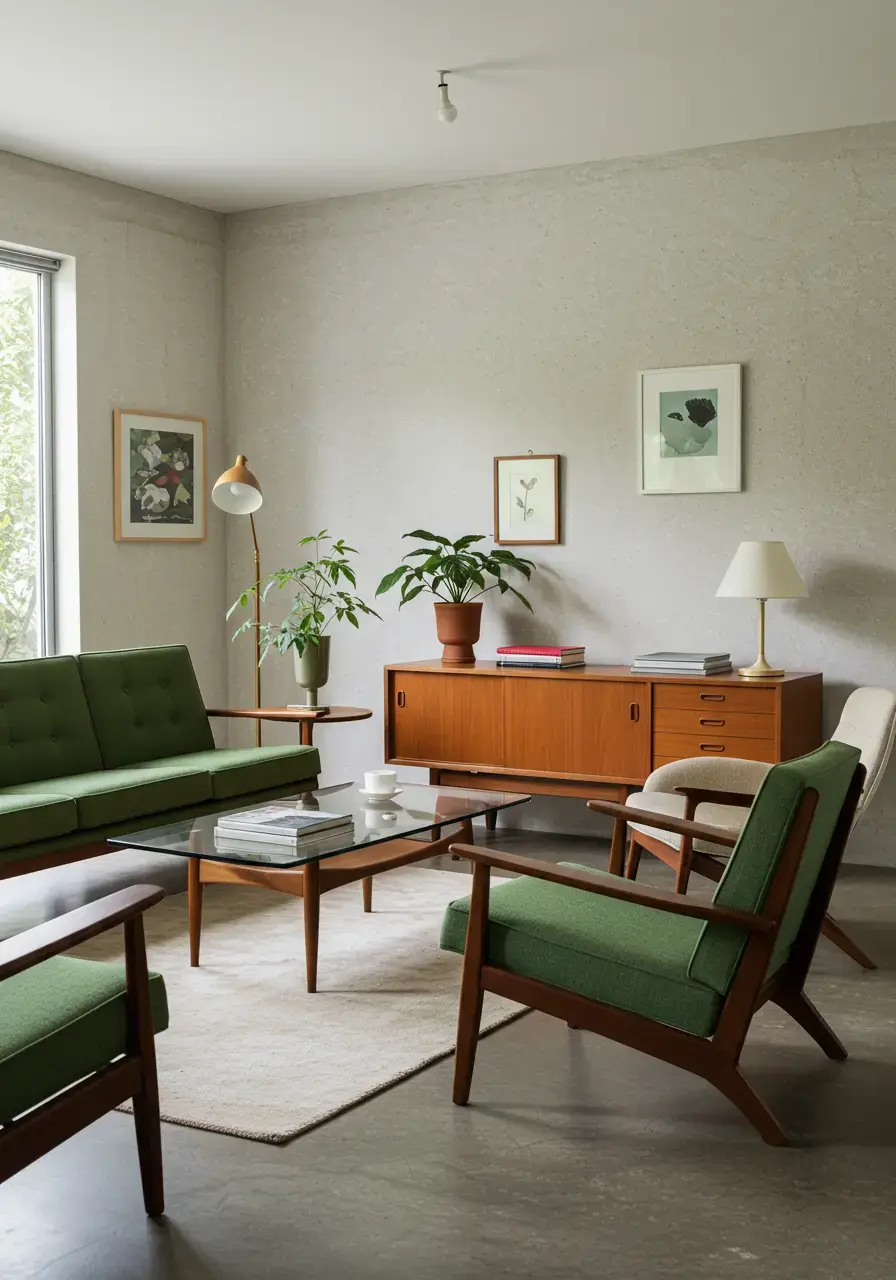
Why This Works:
This approach creates a cohesive and authentic mid-century look, providing key pieces that are both stylish and functional, allowing for a spacious and unfussy environment.
How You Can Recreate It:
- Invest in a low-slung sofa with clean lines and tapered legs, perhaps in a neutral tone like gray or beige, or a bold color like avocado green or teal.
- Add a sleek coffee table, either a solid wood piece with simple lines or one with a glass top to maintain an airy feel.
- Incorporate iconic chairs such as an Eames Lounge Chair, a Saarinen Womb Chair, or simple Danish-inspired armchairs with visible wood frames.
- Consider a credenza or sideboard with sliding doors for storage, made from rich woods like walnut or teak.
Textile Choices for a Mid-Century Living Room
Okay, so you’ve got your furniture, but what about the cozy factor? This is where textiles come into play. For me, it’s about adding warmth and texture without overwhelming the space. I’ve learned that selecting the right fabrics can truly tie everything together, bringing in subtle pops of color and inviting tactile experiences. It’s about balance, really – clean lines mixed with comforting textures. It’s like adding a warm blanket on a cool evening; it just feels right.
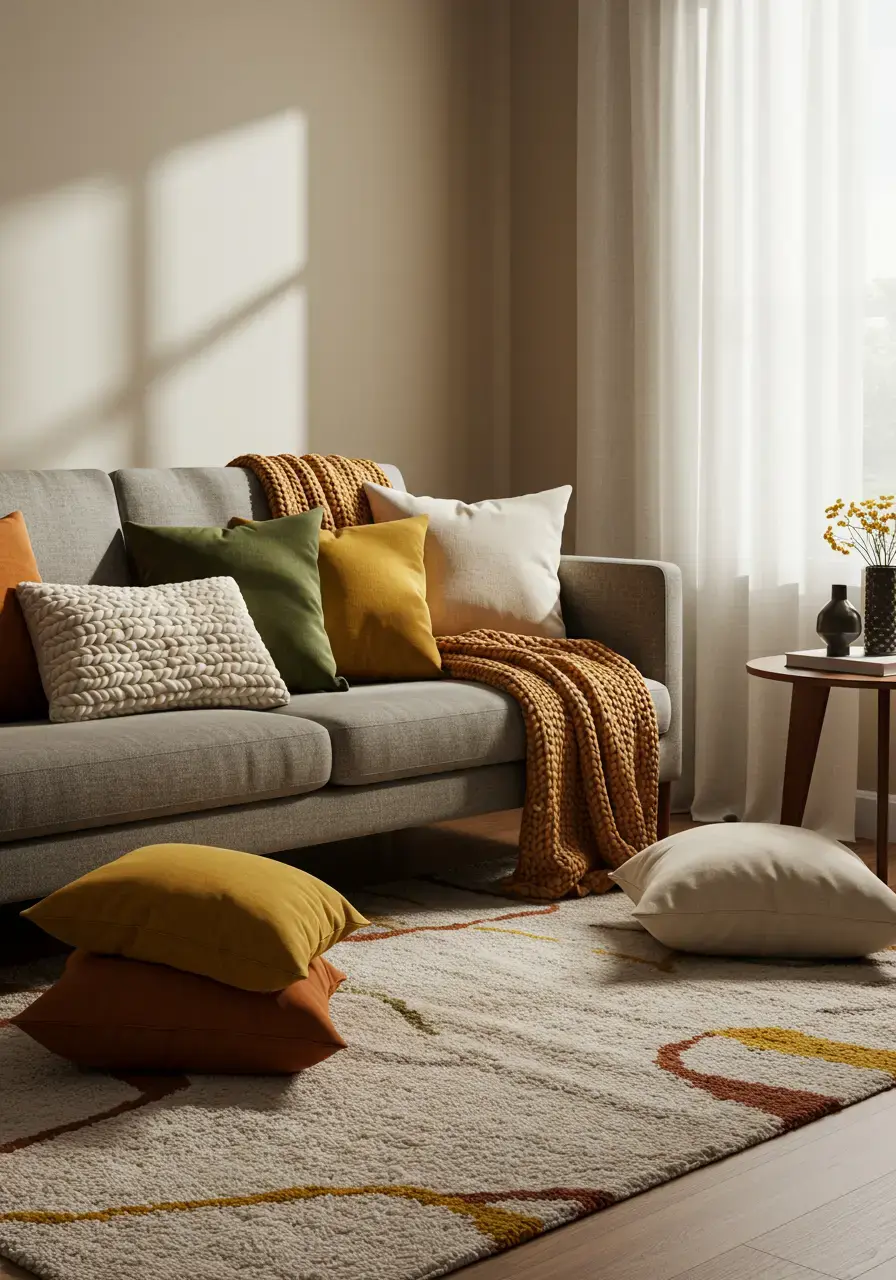
Why This Works:
Carefully chosen textiles add warmth, comfort, and visual interest, softening the clean lines of mid-century furniture and integrating color and pattern without disrupting the minimalist aesthetic.
How You Can Recreate It:
- Choose throw pillows in textured fabrics like wool, velvet, or natural linen, featuring geometric patterns or solid, muted colors.
- Drape a textured throw blanket over your sofa, opting for materials like knitted wool, cashmere, or a soft cotton blend in a complementary color.
- Select area rugs with abstract, geometric, or atomic patterns, or opt for a simple shag rug for a retro feel.
- For curtains, use simple, unlined drapes in a solid color that matches your palette, or consider sheer fabrics for light diffusion.
Mid-Century Living Room Lighting Fixtures
Lighting isn’t just about brightness; it’s about setting the mood. And in a mid-century living room, it’s about iconic design elements that also illuminate. I remember struggling to find the right lamp for ages, and then I stumbled upon a Sputnik chandelier. It was an ‘aha!’ moment. Mid-century lighting fixtures are often sculptural pieces themselves, drawing the eye and becoming a focal point. They add that extra layer of cool without being over the top. It’s like jewelry for your home.

Why This Works:
Mid-century lighting fixtures are often sculptural and serve as prominent design elements, enhancing the retro aesthetic while providing essential illumination and atmosphere.
How You Can Recreate It:
- Install a Sputnik chandelier or a molecular pendant light as a central ceiling fixture.
- Incorporate an arc floor lamp, positioned over a sofa or an accent chair, to provide directed light and a striking silhouette.
- Place table lamps with unique bases (ceramic, wood, or metal) and drum or conical shades on side tables or credenzas.
- Look for lamps made with brass, chrome, or colored glass for an authentic mid-century feel.
Mid-Century Living Room Wall Decor Ideas
The walls in a mid-century living room are not just boundaries; they’re canvases. I’ve always found that the right wall decor can truly amplify the era’s vibe without making the space feel cluttered. It’s about careful curation, choosing pieces that echo the clean lines and artistic sensibilities of the 50s and 60s. I often think about how to add personality without detracting from the overall calm feeling of the room. A well-placed piece of art can really make a statement.

Why This Works:
Thoughtful wall decor enhances the mid-century aesthetic, adding visual interest and personality while maintaining the clean, uncluttered feel characteristic of the style.
How You Can Recreate It:
- Hang abstract expressionist art prints or framed geometric patterns, often featuring bold colors or muted tones.
- Consider a large mirror with a simple, clean-lined frame (wood, brass, or thin metal) to reflect light and expand the space.
- Install a mid-century-inspired wall clock, such as a starburst or sunburst design.
- Add a small collection of decorative wall plates or unique ceramic pieces for textural variety.
Creating a Cozy Mid-Century Living Room Nook
Even in a style known for its clean lines, there’s always room for a cozy nook. I mean, who doesn’t love a spot to curl up with a good book? I’ve found that creating these small, inviting areas within a larger layout really makes a mid-century living room feel more personal and warm. It’s about carving out a space just for you, a little sanctuary amidst the sophisticated setting. I remember making my first one next to a large window, it became my favorite spot.
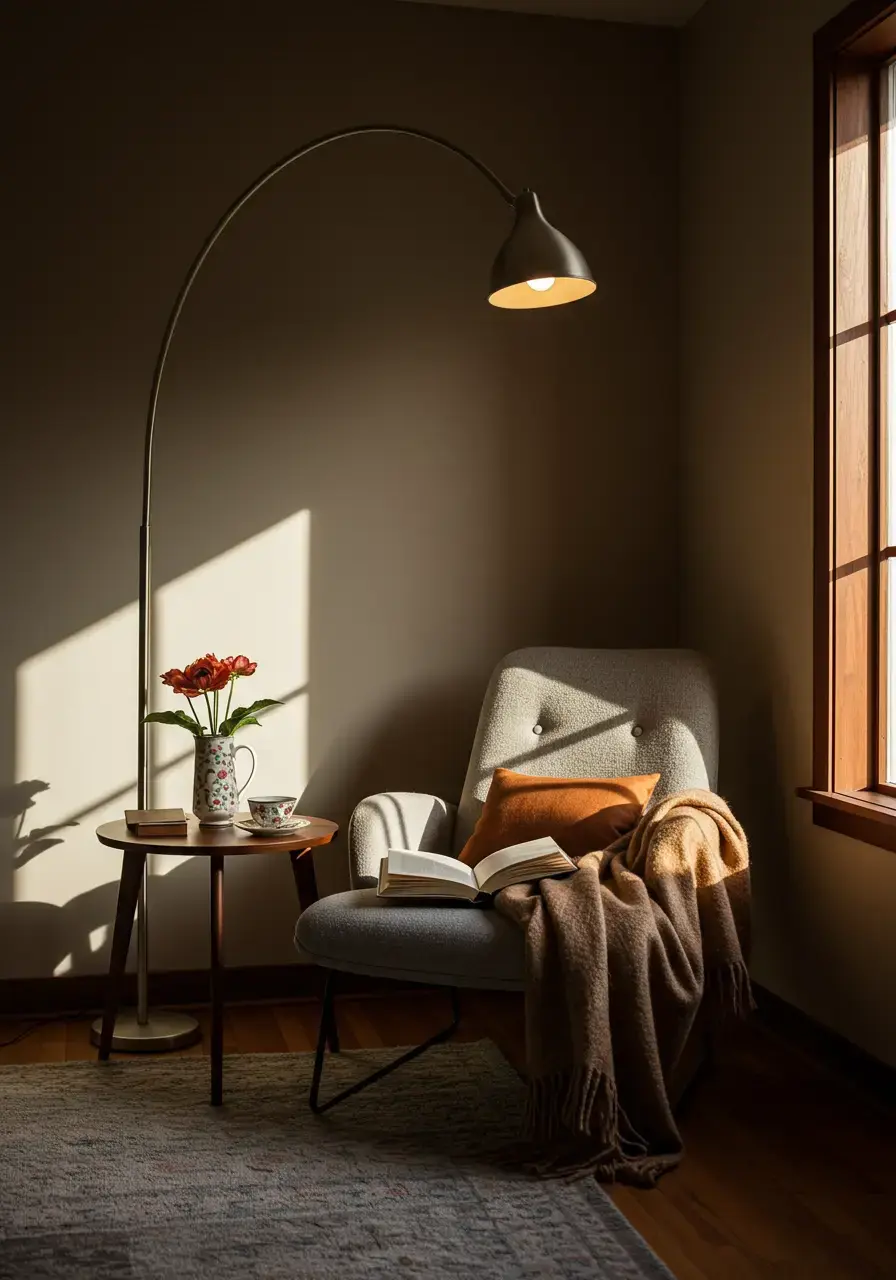
Why This Works:
A cozy nook offers a welcoming, intimate retreat within the living room, balancing the sleekness of mid-century design with comfort and personal relaxation.
How You Can Recreate It:
- Place a comfortable, low-profile accent chair (like an Eames Lounge Chair, a small armchair, or a simple lounge chair) in a corner or beside a window.
- Add a small, round side table next to the chair, for your book and a cup of tea.
- Incorporate a soft throw blanket and a decorative pillow to enhance comfort and visual appeal.
- Place an arc floor lamp or a small table lamp for focused lighting, perfect for reading.
Flooring Options for Mid-Century Modern
The foundation, literally, of your mid-century living room starts with the floor. The right flooring can truly set the stage for all your other design choices. I remember debating between different options for my own space, wanting something that felt authentic but also practical. It’s about choosing materials that reflect the era’s love for natural, durable elements, which really contribute to the overall clean and organic feel. It’s amazing how much difference the floor makes.
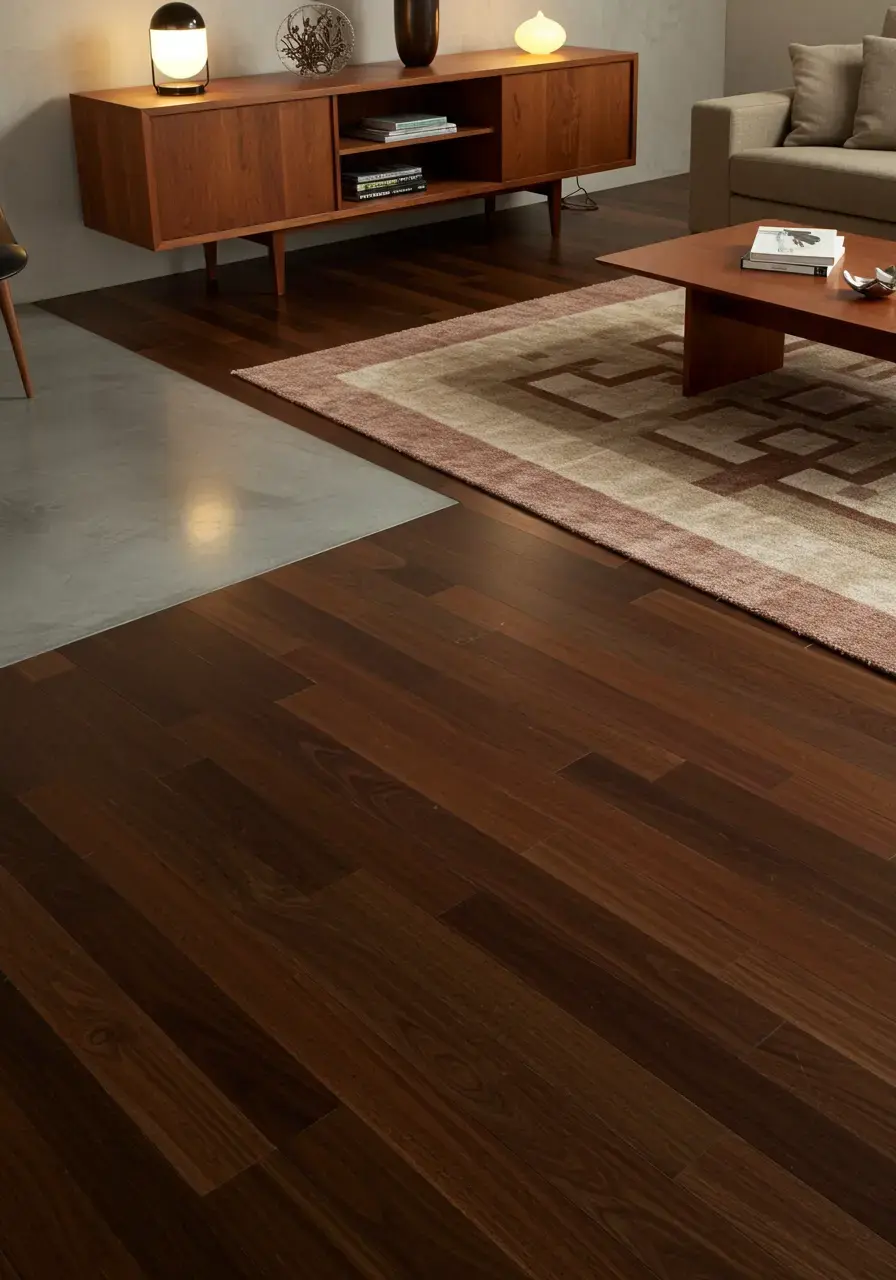
Why This Works:
Appropriate flooring choices provide an authentic foundation for the mid-century aesthetic, enhancing the room’s clean lines and natural material palette.
How You Can Recreate It:
- Install natural hardwood flooring, particularly in medium to dark tones like walnut, teak, or oak, laid in straight planks.
- Consider polished concrete for a more industrial or minimalist take on mid-century, especially effective in open-concept spaces.
- Explore cork flooring, a popular and sustainable choice during the era, for its warmth and sound-dampening qualities.
- Layer with area rugs featuring geometric patterns or solid colors to define zones and add comfort.
Bringing Greenery into Your Living Space
Adding plants isn’t just a trend; it’s practically a requirement for a truly vibrant mid-century living room. This era embraced biophilic design, bringing the outdoors in. I’ve always found that a few well-placed plants can instantly breathe life into a room, softening hard lines and adding a touch of natural beauty. It’s not just about decor; it’s about creating a living, breathing environment. My fiddle-leaf fig really changed the game for me.
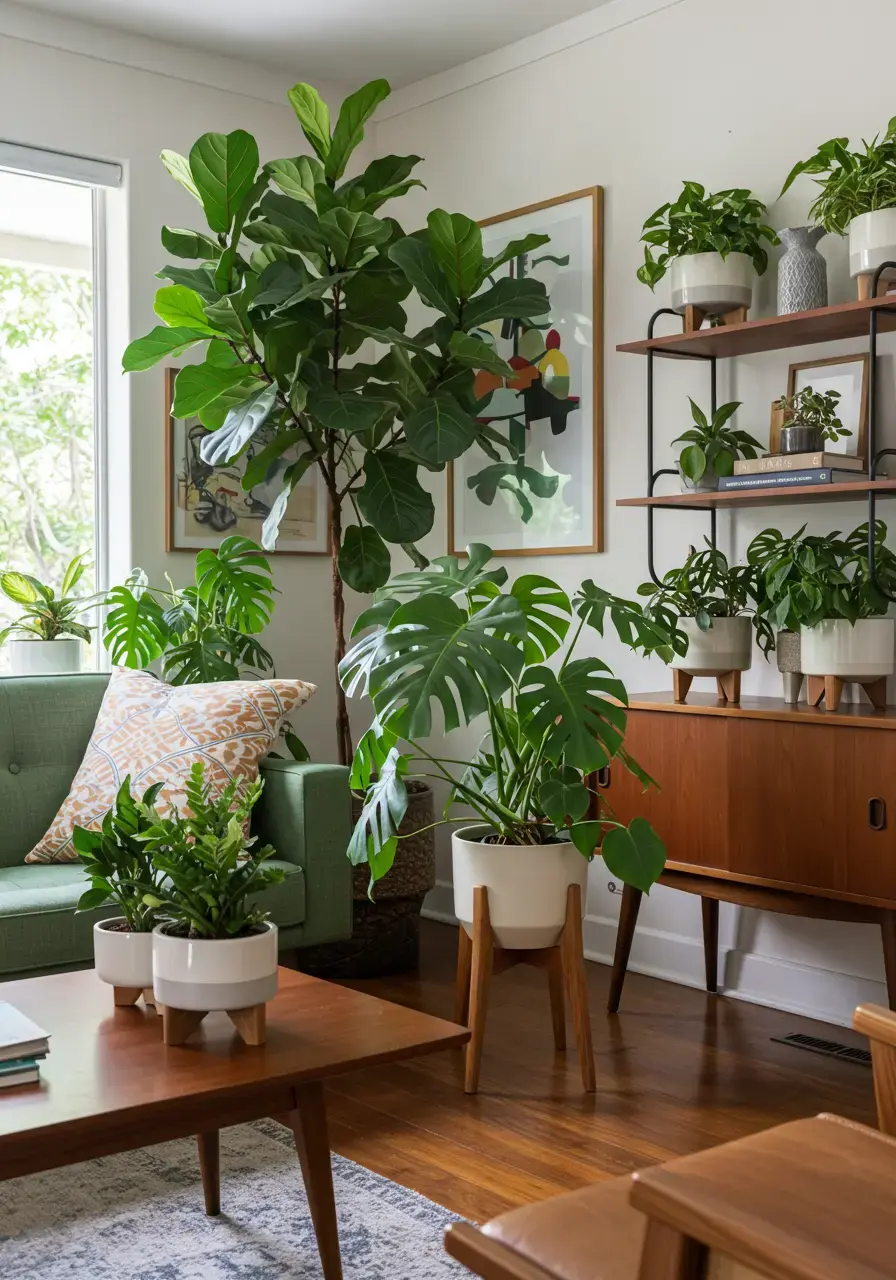
Why This Works:
Integrating greenery softens the architectural lines of mid-century design, adds natural elements, improves air quality, and brings a sense of freshness and life to the space.
How You Can Recreate It:
- Place large, sculptural plants like a Fiddle Leaf Fig, Monstera Deliciosa, or Snake Plant in strategic corners or next to accent furniture.
- Cluster smaller plants on side tables or shelves using ceramic planters with geometric patterns or simple, unglazed finishes.
- Use sleek, elevated planters or plant stands with tapered legs to mimic the era’s furniture design.
- Consider hanging planters for a touch of vertical greenery, especially in areas with limited floor space.
Mid-Century Living Room Color Palettes
Choosing the right colors can feel daunting, but for a mid-century living room, it’s about finding that sweet spot between sophisticated and playful. I always advise starting with a neutral base and then layering in those iconic pops of color. Think about the colors that were trending back then: the earthy tones, the vibrant accents. It’s not about bright, overwhelming colors; it’s about a more nuanced approach. Color tells a story in any room, and the mid-century story is one of understated cool.

Why This Works:
A well-chosen color palette defines the mid-century aesthetic, creating a harmonious and authentic backdrop that allows the furniture and decor to shine.
How You Can Recreate It:
- Start with a neutral base for walls and larger furniture pieces: off-white, light gray, muted beige, or even a soft blue-gray.
- Introduce accent colors through textiles, art, and smaller decor items in shades like avocado green, mustard yellow, burnt orange, teal, and charcoal gray.
- Combine warm wood tones (walnut, teak) with metallic accents like brass or brushed chrome.
- Consider a single accent wall in a bolder, period-appropriate color to define a specific area.
Smart Storage Solutions for Living Rooms
In a mid-century living room, clutter is the enemy of cool. But let’s be real, we all have stuff! This is where smart storage comes in. The beauty of mid-century design is how cleverly it integrates storage into furniture pieces. I’ve always appreciated how the design allows for organization without sacrificing style. It’s about keeping things tidy and making sure every item has its place, which really contributes to that clean, open feeling. My vintage credenza is a lifesaver for this.

Why This Works:
Smart storage solutions maintain the clean lines and uncluttered aesthetic of mid-century design, ensuring functionality without compromising style.
How You Can Recreate It:
- Utilize credenzas and sideboards with sliding or flush doors to hide media equipment, books, and other items.
- Choose coffee tables and end tables that incorporate concealed drawers or open shelving for discreet storage.
- Install floating shelves with clean lines to display decorative items while keeping electronics or books neatly organized.
- Look for multi-functional furniture, like an ottoman with hidden storage, to maximize space and utility.
Accessorizing Your Mid-Century Living Room
Accessories are the finishing touches, the cherry on top. For a mid-century living room, it’s about choosing pieces that are both decorative and reflective of the era’s design principles. I think of accessories as small moments of joy, little details that tell a story without shouting. It’s about curation, rather than accumulation, allowing each piece to stand out. It’s like adding the perfect necklace to an outfit, it just completes the look.
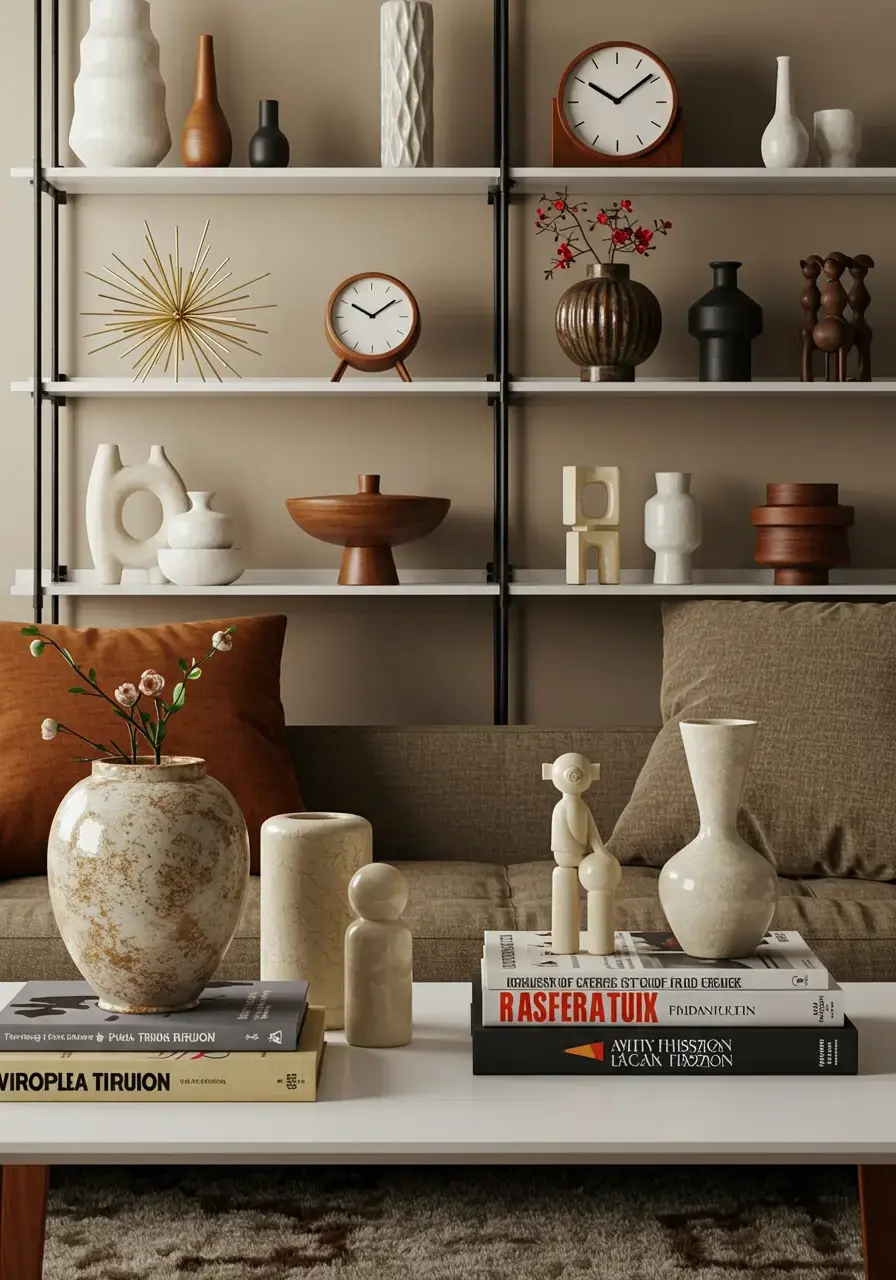
Why This Works:
Carefully selected accessories reinforce the mid-century aesthetic, adding personality and visual interest without cluttering the clean lines of the space.
How You Can Recreate It:
- Display ceramic vases or decorative bowls with organic shapes or geometric patterns.
- Place retro-inspired clocks, such as starburst or simple, minimalist designs, on shelves or tables.
- Incorporate small sculptures or figurines made of wood, brass, or ceramic.
- Use a few well-chosen books with striking mid-century covers as decor on coffee tables or shelves.
Vintage Finds for an Authentic Living Room
Hands down, one of my favorite parts of creating a mid-century living room is the thrill of the hunt for vintage finds. There’s something truly special about owning a piece with a story, something that has stood the test of time. It brings an unparalleled authenticity to the space that mass-produced items just can’t replicate. I remember finding a set of original Danish modern dining chairs at an antique market; it felt like winning the lottery! These pieces truly encapsulate the spirit of the era.
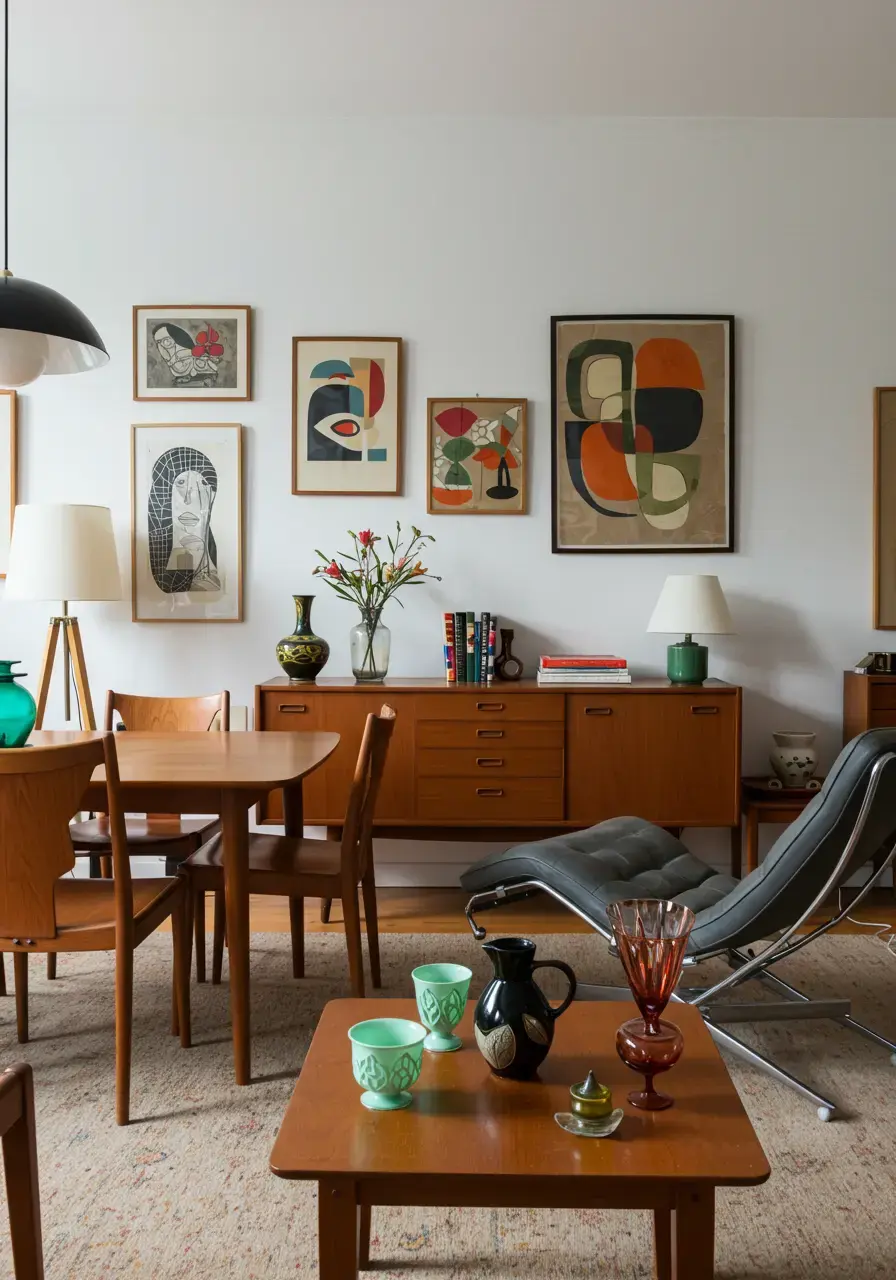
Why This Works:
Vintage finds inject unparalleled authenticity and character into a mid-century living room, providing unique, high-quality pieces with a history that store-bought items cannot replicate.
How You Can Recreate It:
- Scour antique shops, flea markets, and consignment stores for original mid-century furniture and decor.
- Look for iconic pieces like credenzas, side tables, and lounge chairs that might need some restoration but offer genuine charm.
- Seek out vintage lighting fixtures, abstract art, ceramic pottery, or glassware from the 1950s and 60s.
- Be patient; the best finds often take time, but their uniqueness is worth the search.
Open-Concept Mid-Century Living Room Layouts
Mid-century design often embraced open-concept living, blurring the lines between different functional areas. I’ve found this approach incredibly liberating, creating a sense of spaciousness and flow. It’s about making the most of your square footage, allowing natural light to permeate, and making the entire area feel connected. Even if your space isn’t fully open, you can create the illusion of it through clever furniture arrangement. It truly makes a home feel more expansive and inviting.

Why This Works:
Open-concept layouts enhance the spaciousness and flow of a mid-century living room, promoting natural light and a cohesive design feel by minimizing visual barriers.
How You Can Recreate It:
- Use area rugs to define distinct zones within the open space, such as a seating area or a reading nook.
- Arrange furniture to create pathways and define areas without using physical walls or bulky room dividers.
- Position low-profile furniture to maintain clear sightlines throughout the room.
- Ensure a cohesive color palette and consistent use of materials (e.g., wood tones, metal finishes) across all areas to maintain unity.
DIY Projects for Your Living Room Style
Now, for my absolute favorite part: getting your hands dirty with a little DIY! You don’t need a huge budget to infuse mid-century charm into your living room. Some of the most satisfying transformations I’ve witnessed (and done myself!) have come from simple, creative projects. It’s about putting your personal stamp on the space, and adding warmth that only handmade touches can provide. I once revived an old side table with a fresh coat of paint and new tapered legs, and it looked like a million bucks. It’s amazing what you can achieve with a bit of elbow grease.
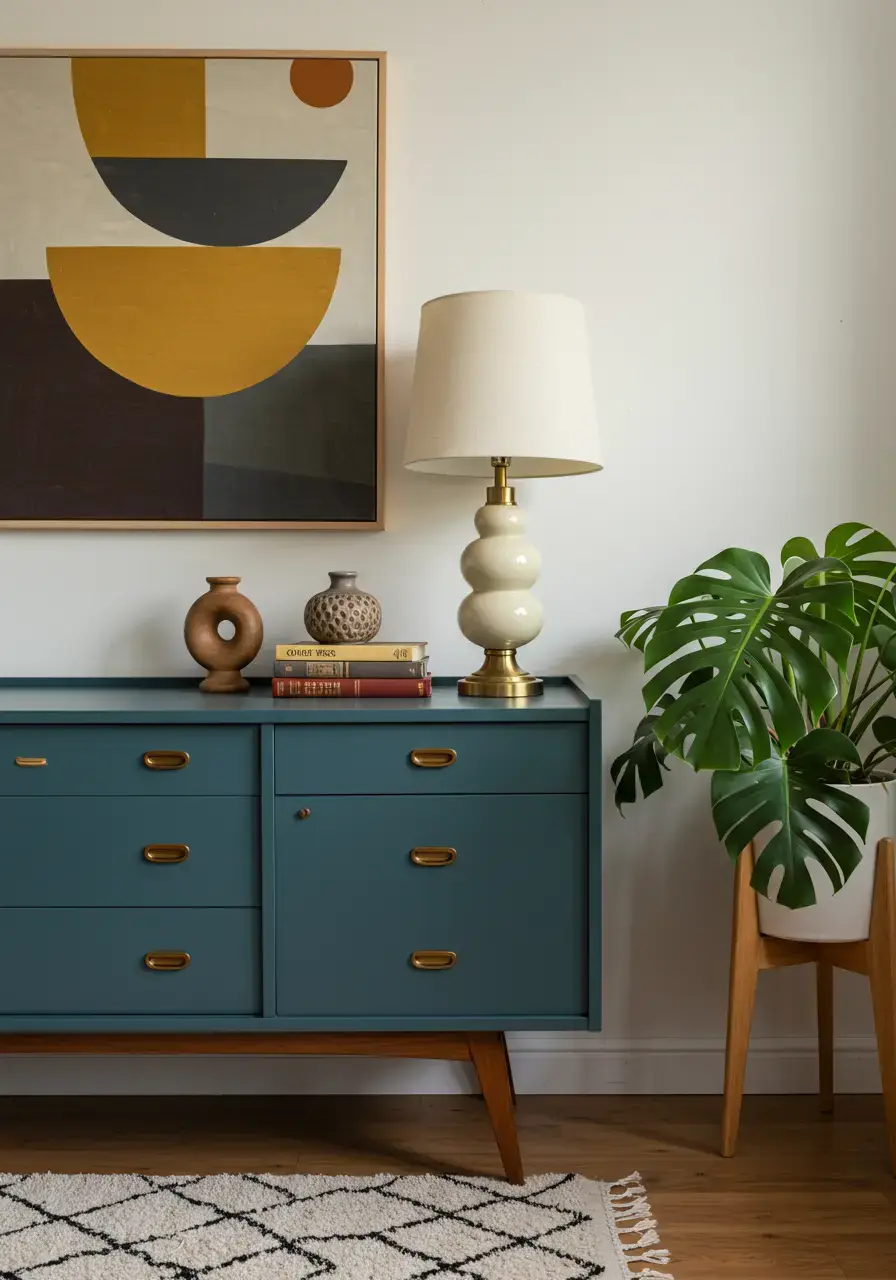
Why This Works:
DIY projects offer a cost-effective and personalized way to enhance your mid-century living room, allowing for creative expression and a unique touch that store-bought items can’t provide.
How You Can Recreate It:
- Refinish or paint a vintage dresser or cabinet to use as a credenza, adding tapered wooden legs for an instant mid-century update.
- Create custom abstract art by painting geometric shapes or color blocks on a canvas.
- Make your own mid-century inspired plant stands using simple wood dowels or repurpose old wooden stools.
- Restore old lamps by replacing shades with drum or conical designs and updating wiring for safety.
Conclusion
Transforming your living space into a mid-century marvel is truly a journey of passion and discovery. From the sleek lines of its furniture essentials to the vibrant pops of its iconic color palettes, every choice you make weaves together a story of retro charm and timeless style. Embrace the hunt for those unique vintage finds, play with textiles to add warmth, and don’t shy away from bringing the calming presence of greenery into your home. Each of these 13 Mid-Century Living Room Ideas offers a pathway to create a space that’s not just beautiful, but deeply personal and inviting. Remember, your home should be your sanctuary, a place that reflects your unique taste and brings you joy. So go on, mix and match, experiment, and most importantly, have fun creating the mid-century living room of your dreams!
